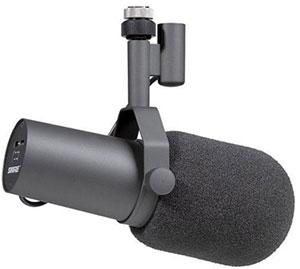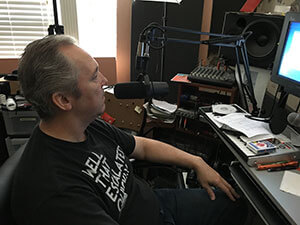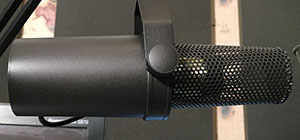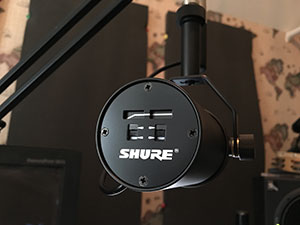
I’ve been wanting to get my grubby little hands (he actually wears X-Large gloves) on a Shure SM7B dynamic microphone to review for Home Brew Audio for quite awhile. And last week I landed one. Yes!
This mic is designed specifically for vocals. And what makes it so special for me is that unlike most of the vocal microphones I talk about for studio vocal recording, the SM7B is a dynamic microphone (as opposed to a condenser mic – check out my article What Is the Difference Between Condenser and Dynamic Microphones? for a review of what that means).
For this review, I put The SM7 to the test, comparing it to my studio workhorse, the Rode NT2-A large diaphragm condenser (LDC) microphone. In addition to the audio recordings of that comparison, I recorded my voice both with and without the SM7’s supplied A7WS windscreen, which Shure describes as being “for close-talk applications, such as voice overs or radio announcements.” The A7WS is an alternative to the standard thinner screen that the mic usually wears. I also recorded a sample with the bass roll off switch engaged (Yup it has one. I didn’t know either!).
So what did you think already?
One of the first things I noticed when I opened the box was the way the bracket was already attached to the mic. This was good news. Having only seen the mic in pictures, hanging from its yoke-shaped bracket, I thought it was going to be difficult to set it up. But it turned out to be super simple, much easier than any of the shock mounts you have to deal with when setting up large diaphragm condenser (LDC) mics.

The mic itself is a large, heavy and very sturdy piece of kit. Like most dynamic mics, the SM7 is an “end-address” mic, meaning you talk into the end of the cylinder. This made it much easier for me to see my computer screen when speaking into the mic as it hung from my desk boom stand. See figure 2. It’s pretty hard to see around my side-address Rode LDC mic, with its mandatory pop-filter.
Also, the SM7 is a cardioid mic, which means it’s a directional mic, picking up best what is directly in front of it, and rejecting sound from the rear. For a review on mic pickup patterns, see my article Directional and Omnidirectional Microphones – What Are They Good For?
Anyway, I was anxious to record my voice with the SM7, so I wrote a quick script so I could record the exact same thing with both mics and all the different configurations of the SM7.
The audio samples
Below are all the recordings I made for this review. I highly recommend listening to them with headphones if you can. That will allow you to hear subtle differences more clearly. Pay particular attention to the p-pops in all the recordings. IMPORTANT: I purposely did not edit ANY of the plosives/p-pops in these recordings, since one of the main advantages of using a dynamic mic should theoretically be fewer p-pops in the recording. All recordings were made with the mic plugged into my Focusrite 2i2 audio interface. Because the SM7 is a dynamic mic, you should turn OFF the phantom power on your interface units.
First I recorded as I normally do – using my rode NT2-A on cardioid setting with an sE Electronics metal pop filter. Below is what that sounded like:
Audio Player
Next I recorded the same script with the SM7B. Below is that sounded like:
Audio Player

For the third test recording, I removed the standard (thinner) wind screen from the SM7 and put the thicker A7WS windscreen onto the mic. I took a picture of what the mic looked like with no windscreen at all (you should not record without a windscreen of some kind, BTW) while I was changing the screens. See Figure 3. Once the A7WS was on, the mic looked like it does in the fist picture at the top left of this page. Theoretically, this recording should not have had as many pop-pops as either of the previous two recordings. I’ll let you be the judge. Take a listen to that sample below:
Audio Player
The thing I almost missed

I had already finished (I thought) the recordings for this review when I read something in the manual that surprised me. Apparently there are two switches on the SM7B – a bass roll off switch and a mid-range emphasis (presence boost) switch. On every other mic I’ve ever used, any tone switches are clearly visible right on the body of the microphone. But the SM7B body is a smooth as a baby’s bottom. No switches. I had to read the fine print to find out where these switches were. It turns out they are on the back end of the mic. See figure 4.
I definitely wanted to record a sample with the bass roll off switch engaged, but I couldn’t figure out how to move the switch! I couldn’t do it with my little finger, which is usually how these things are done. The manual had nothing to say on the matter. I ended up looking at a forum on the internet before I discovered that others usually use the tip of a small screwdriver or a paper clip. I grabbed a small paperclip and with the curved end was able to move the switch. THAT was an unexpected difficulty.
Anyway, the reason I wanted to flip the switch is that “rolling off the bass” reduces the sensitivity of the mic in the bass frequencies. Since p-pops live in the bass range, I hoped I could get a nice rich sound AND be totally p-pop free with this switch turned on. I was half right. The p-pop problem virtually vanishes on this setting. But the reduced bass in the recording sort of takes the richness away also. This will vary from voice to voice. So your mileage on this score may vary.
The below recording has the bass roll off switch engaged AND the A7WS windscreen on the mic:
Audio Player
Overall impressions?
I was impressed with how great the Shure sounded compared to the more expensive Rode NT2A ($399). Just to be sure (ha!) I wasn’t imagining it, I asked my wife, the lovely and talented Lisa Theriot, to come up and do a blind test of the recordings. Without knowing what recordings she was listening to, she chose the SM7B (though NOT the sample with the bass roll off switch on) as the best sounding audio by a significant amount. For her, the difference was very clear. She described the SM7 audio as rich and “chocolate-y”:).
She chose the SM7B as the best sounding audio by a significant amount. For her, the difference was very clear. She described the SM7 audio as rich and “chocolate-y”:).
I heard the difference also. Besides the overall sound being better, the p-pops were certainly reduced with the Shure, though I was hoping that they would be close to non-existent. Some p-pops still came through on the SM7 recordings, even though as a dynamic mic it theoretically should have been much less sensitive to the plosives. But then again, I’ve noted in the past that my “Ps” are made of stronger stuff than many folks. I think my expectations in this area may be a tad unreasonable. It will be interesting to hear how another popular dynamic mic – the Electrovoice RE20 – sounds in next week’s review:).
One other huge plus of this mic is how quiet the background nose is! This is a double-bonus for folks recording voice-overs in the standard boxy room at home. Not only does the cardioid pickup pattern reject noise from most of the room, but the lower sensitivity of a dynamic mic helps reduce any background noise even more, improving the sound quality of your home recordings.
The Shure SM7B is an amazing microphone. I never knew a dynamic mic could sound so good. It’s perfect for voice-over actors, podcasters, or anyone recording vocals. It is incredible at not picking up extraneous noises in the background, so it’s almost tailor-made for folks who record vocals at home in less than ideal acoustic rooms. The SM7B costs $349, which is a bit higher than your entry-level LDC mics. But for the quality and features you cannot go wrong with this microphone. CLICK HERE to find out more or to order one of your own.
Great review Ken, thank you for taking the time.
Thanks Dan!
Ken
Thanks for the excellent review! I recently purchased the SM7B and enjoying how to use the mic.
Jim
You’re welcome, James!
Greetings and thanks for the test
How far from the microphone are you talking about in the test?
the audio comes directly connecting the sm7b to the interface without any kind of processing and eq?
You’re welcome! And you are correct – no processing or EQ of any kind. I’m about 4-5 inches from the mic.
If you
want to hear conga drums the way they are supposed to sound. Use this mic.
A. Terron
Thanks for the tip!